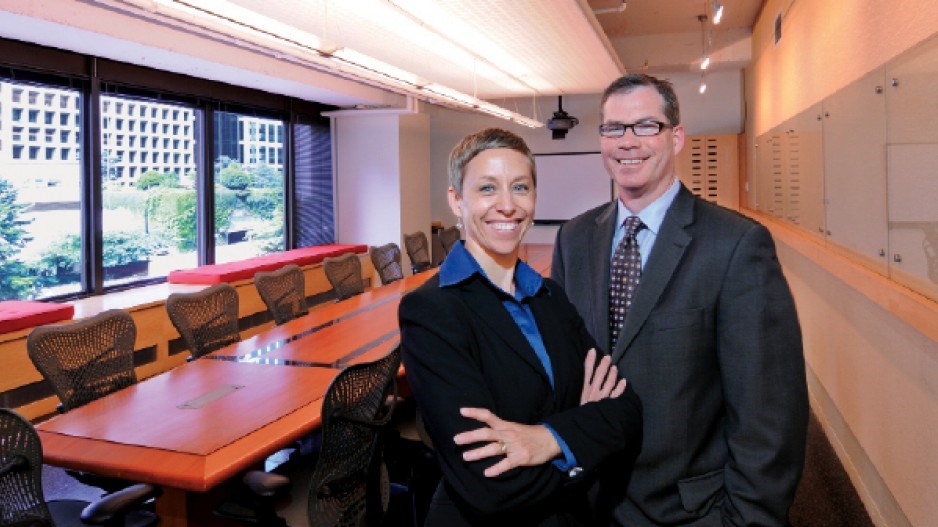Of all the emergencies that may be anticipated by people who work in Vancouver’s office towers, a flood may seem the most unlikely. But one recent spring morning, staff from Omicron arrived at Bentall Three tower to learn their two lower floors had flooded due to a broken water pipe on the 18th floor.
Omicron’s offices suffered the worst damage and were pooled with several inches of water, along with water-ravaged computers and workspaces.
“When I had my first look at our office space, it was like a war zone. I was amazed by the power of water; it’s so destructive,” said Bev Attfield, director of marketing and communications for Omicron.
With more than 120 staff, Omicron is one of Western Canada’s largest integrated design and construction firms. Communication is number 1 priority to keep projects running.
“We’re unique in the marketplace and effective messaging is critical. [Our response] had to be timely, as the entire industry is schedule and deadline driven,” said Bill Tucker, CEO of Omicron.
For Attfield, the flood required a multi-channel and immediate communication approach for staff as well as clients whose projects were affected. It reflected the brand’s existing communication strategy.
“We use a combination of traditional and new marketing channels,” said Attfield. “Our emphasis is on sustainability so we are moving away from printed material. Brochures have been replaced with memory sticks loaded with data or QR codes.”
Omicron is also working with Industrial Brand, an agency that specializes in working with partner-driven professional services firms, to evaluate its goals and marketing rebrand strategy.
“Omicron has to look at all opportunities of online and offline media and evaluate them to decide which platforms to be on. There is no single solution,” said Ben Garfinkel, partner and strategy director of Industrial Brand.
Attfield’s marketing team used new media as well as traditional methods while the office was shut down for a day and a half and in the weeks of the flood’s aftermath.
“We used different channels to communicate with people, from internal staff to our clients. Our employees’ health and safety concerns were our first priority as people came to work and wanted access to the building,” said Attfield.
The first line of communication was the most traditional: word-of-mouth. The company’s phone system operated through its servers, which were flooded, so calls and voicemails were not an option. Key members of staff met people in the lobby and were told to return home to await further instructions.
Next, Attfield’s team prepared a response for staff and used an iPhone app to send a blanket text message to 150 cell phones of the staff. Then they sent an email blast to 3,500 clients using MailChimp, a cloud-based email marketing system. For clients whose projects would be affected by the delays, Omicron needed to diminish the damage with remote working options.
“There was a fantastic response from people to the flood. It really speaks to our industry. Our competition actually stepped up and offered their extra desks and workspace to help us out and keep us working,” said Tucker.
Meanwhile, the marketing team put together a blog in WordPress to provide real-time updates. The blog was launched the first day of the flood and its link was sent in a text to staff.
“The staff was very grateful we were able to provide a robust source of information so quickly. It provided a sense of calm and order,” said Attfield.
After the second day of the flood, people were able to return to the office but it took weeks to repair the damage and replace highly specialized equipment. Ceiling tiles, carpeting and baseboards had to be replaced as well as about 100 damaged computers and high-end drawing software.
Today, Omicron is fully functional and the flood is a memory, until someone opens a seldom-used file drawer to find water. It serves as a reminder that communicating a message to the right audience using the right channel is crucial.
“In traditional advertising, you know who to talk to and how to reach them,” said Garfinkel. “The ways people interact with digital content has changed with smaller devices like smartphones, iPads and laptops. Businesses can’t rely on one medium. You need to create layers to build messaging and your brand.”
“There is no single way to communicate with clients anymore,” said Tucker. “Bev and her team have always demonstrated an interest in social media and quickly found innovative ways to deliver the message.”
Said Attfield: “It’s very important to have consistent messaging and and be very nimble and agile. It was a good experience to go through and test systems and review things we would now do differently. In the future we will use Twitter, a more robust and immediate solution than blog, which is more static,” said Attfield.




